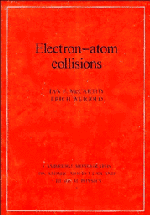Book contents
- Frontmatter
- Contents
- Preface
- 1 Introduction
- 2 Experimental techniques for cross-section measurements
- 3 Background quantum mechanics in the atomic context
- 4 One-electron problems
- 5 Theory of atomic bound states
- 6 Formal scattering theory
- 7 Calculation of scattering amplitudes
- 8 Spin-independent scattering observables
- 9 Spin-dependent scattering observables
- 10 Ionisation
- 11 Electron momentum spectroscopy
- References
- Index
Preface
Published online by Cambridge University Press: 15 December 2009
- Frontmatter
- Contents
- Preface
- 1 Introduction
- 2 Experimental techniques for cross-section measurements
- 3 Background quantum mechanics in the atomic context
- 4 One-electron problems
- 5 Theory of atomic bound states
- 6 Formal scattering theory
- 7 Calculation of scattering amplitudes
- 8 Spin-independent scattering observables
- 9 Spin-dependent scattering observables
- 10 Ionisation
- 11 Electron momentum spectroscopy
- References
- Index
Summary
The advancement of knowledge of electron–atom collisions depends on an iterative interaction of experiment and theory. Experimentalists need an understanding of theory at the level that will enable them to design experiments that contribute to the overall understanding of the subject. They must also be able to distinguish critically between approximations. Theorists need to know what is likely to be experimentally possible and how to assess the accuracy of experimental techniques and the assumptions behind them. We have aimed to give this understanding to students who have completed a program of undergraduate laboratory, mechanics, electromagnetic theory and quantum mechanics courses.
Furthermore we have attempted to give experimentalists sufficient detail to enable them to set up a significant experiment. With the development of position-sensitive detectors, high-resolution analysers and monochromators, fast-pulse techniques, tuneable high-resolution lasers, and sources of polarised electrons and atoms, experimental techniques have made enormous advances in recent years. They have become sophisticated and flexible allowing complete measurements to be made. Therefore particular emphasis is given to experiments in which the kinematics is completely determined. When more than one particle is emitted in the collision process, such measurements involve coincidence techniques. These are discussed in detail for electron–electron and electron–photon detection in the final state. The production of polarised beams of electrons and atoms is also discussed, since such beams are needed for studying spin-dependent scattering parameters. Overall our aim is to give a sufficient understanding of these techniques to enable the motivated reader to design and set up suitable experiments.
- Type
- Chapter
- Information
- Electron-Atom Collisions , pp. xi - xiiPublisher: Cambridge University PressPrint publication year: 1995

